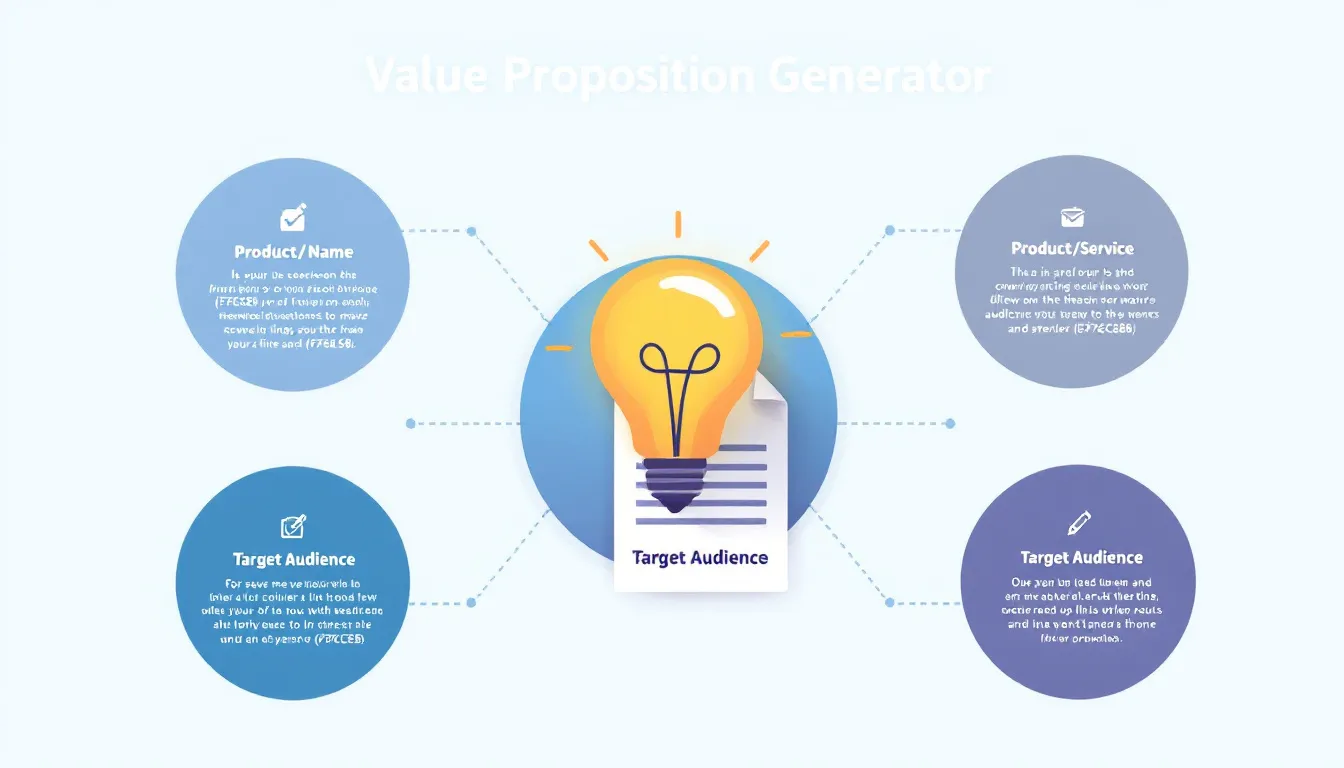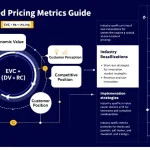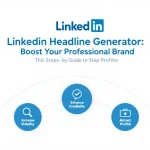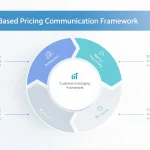Is this tool helpful?
How to Use the Value Proposition Generator Effectively
This Value Proposition Generator helps you craft clear and compelling statements that communicate the unique worth of your product or service. To get the best results, fill out the form with precise and targeted information in the following sections:
- Product or Service Name: Input the exact name or a concise description of your product or service. For example, use “Smart Fitness Tracker” or “Customized Home Cleaning Service”.
- Target Audience: Define the specific group of customers you want to reach. Examples include “Busy parents aged 28-45” or “Freelancers in creative industries”.
- Key Features & Benefits: Highlight what makes your offering valuable by listing unique features and main benefits. For example, “Real-time health monitoring, personalized workout plans” or “Eco-friendly products, flexible scheduling”.
- Competitive Advantage (Optional): Share what sets you apart from competitors. You might mention “24/7 customer support” or “Exclusive partnerships with leading brands”.
- Industry Context (Optional): Add relevant market or industry details to provide background, such as “Fitness wearable technology market” or “Residential cleaning services sector”.
Introduction to the Value Proposition Generator
The Value Proposition Generator is designed to help you create focused and persuasive value statements that explain why customers should choose your product or service over others. Its purpose is to simplify the process of expressing your offering’s unique benefits and features clearly. By using this tool, you can save time on marketing message development and ensure consistency across your communications.
This tool guides you through important aspects of your product or service and combines them into a clear value proposition. It helps you identify and express your unique selling points, making it easier to connect with your ideal customers.
Practical Usage of the Value Proposition Generator
Once you fill in the form with your product or service details, target audience, features, and optional advantages or industry information, the generator processes your inputs and produces a clear, concise value proposition. Use the generated statement across your marketing channels to improve communication and attract your target customers.
Example 1: Educational Platform
- Product: Interactive Online Language Learning Platform
- Target Audience: Adult learners aged 18-50 seeking flexible education options
- Features: Live tutoring, personalized learning paths, progress tracking
- Competitive Advantage: Access to native speakers, gamified lessons
Generated Value Proposition: “Help adult learners achieve fluency through flexible, personalized language courses featuring live tutors and engaging gamified lessons, making learning more effective and enjoyable.”
Example 2: Health & Wellness Service
- Service: Mobile Massage Therapy for Remote Workers
- Target Audience: Remote employees aged 25-55 feeling workplace strain
- Features: On-site massages, stress relief techniques, flexible scheduling
- Competitive Advantage: Certified therapists, eco-friendly products
Generated Value Proposition: “Deliver convenient mobile massage therapy tailored for remote workers, relieving stress and improving wellness with certified therapists using eco-friendly products.”
Using Your Value Proposition Strategically
Apply your generated value proposition in these key areas to maximize impact:
- Homepage or landing pages of your website
- Email marketing campaigns and newsletters
- Sales meetings and presentations
- Social media bios and posts
- Investor pitches and business proposals
- Brochures, flyers, and other marketing materials
Tips to Optimize Your Value Proposition
- Test different versions to see which resonates best with your audience
- Update your message regularly based on market trends and customer feedback
- Ensure alignment with your overall brand voice and messaging across all channels
- Keep your statement focused on customer problems and benefits
Understanding Value Propositions: Core Elements
A strong value proposition includes three essential parts that make it effective:
- Relevance: Clearly shows how your product or service solves a customer’s problem or meets their needs.
- Quantified Value: Specifies the measurable benefits customers can expect.
- Differentiation: Highlights what makes your offering unique compared to competitors.
Benefits of Using the Value Proposition Generator
Save Time and Resources
Creating strong value propositions usually takes research and multiple revisions. This generator speeds up the process by:
- Reducing drafting time from hours or days to minutes
- Helping maintain consistent messaging throughout your marketing materials
- Allowing you to focus your efforts on delivering value instead of formulating messages
Gain Strategic Clarity
This tool clarifies your unique offerings by guiding you to:
- Define your core benefits clearly and concisely
- Identify competitive advantages that matter to your audience
- Align product features with customer pain points and desires
Solving Common Marketing Challenges
Typical Issues Addressed
- Inconsistent messaging across marketing channels
- Difficulty standing out in crowded marketplaces
- Unclear communication about product benefits
- Failing to connect with the specific needs of your target audience
How the Tool Helps
By creating focused and audience-centric value propositions, this generator supports consistent, clear messaging that you can use across websites, social media, emails, and sales materials.
Best Practices for Developing Value Propositions
Research and Preparation
- Conduct detailed market research to understand your customers’ needs
- Analyze competitors’ messaging to identify your unique position
- Gather feedback directly from customers when possible
- Pinpoint key pain points your product or service addresses
Drafting and Refinement
- Use clear, straightforward language that your audience understands
- Focus on explaining benefits rather than just listing features
- Include specific, measurable outcomes when available
- Test your propositions with actual or potential customers for feedback
Implementation and Monitoring
- Track customer responses and engagement with your messaging
- Measure conversion or sales performance related to your proposition change
- Seek ongoing feedback to understand message effectiveness
- Adjust your value proposition based on new insights and market shifts
Frequently Asked Questions about Value Propositions
How often should I update my value proposition?
Update your value proposition at least quarterly or whenever there are significant changes in your market, features, or competition.
Can I create different value propositions for multiple audience segments?
Yes. Tailoring value propositions to specific customer groups increases relevance and impact.
How do I integrate my value proposition into my marketing mix?
Use the value proposition as the core message throughout all your marketing materials, adjusting tone and format to suit channels while maintaining consistency.
What makes a value proposition effective?
An effective value proposition is focused, clear, customer-centric, and highlights specific benefits that distinguish your offering from competitors.
Should I mention price in my value proposition?
Unless your price is your main selling point, emphasize the value and benefits first. Price details can be communicated separately.
Can I use the value proposition for investor pitches?
Yes. A concise value proposition helps investors understand your market position and business potential quickly.
Important Disclaimer
The calculations, results, and content provided by our tools are not guaranteed to be accurate, complete, or reliable. Users are responsible for verifying and interpreting the results. Our content and tools may contain errors, biases, or inconsistencies. Do not enter personal data, sensitive information, or personally identifiable information in our web forms or tools. Such data entry violates our terms of service and may result in unauthorized disclosure to third parties. We reserve the right to save inputs and outputs from our tools for the purposes of error debugging, bias identification, and performance improvement. External companies providing AI models used in our tools may also save and process data in accordance with their own policies. By using our tools, you consent to this data collection and processing. We reserve the right to limit the usage of our tools based on current usability factors.







